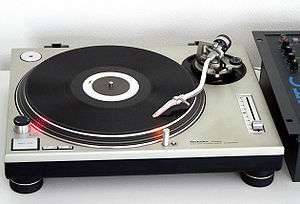Direct-drive turntable

A direct-drive turntable is one of the three main phonograph designs currently being produced. The other styles are the belt-drive turntable and the idler-wheel type. Each name is based upon the type of coupling used between the platter of the turntable and the motor.
Design
In a direct-drive turntable the motor is located directly under the center of the platter and is connected to the platter directly. The first commercially available direct-drive turntable, the model SP-10, was introduced by the Technics division of Matsushita in 1969. Technics also introduced the first direct-drive tangential-arm turntable, the model SL-10, in 1981.
Direct-drive turntables may suffer from vibration due to the motor. This is less of an issue for belt-drive turntables. However, in recent years, shock-absorbing (less dense) material, placed between the motor and platter, has been used to cut back on vibrations. The torque on direct-drive turntables is usually much higher than on belt drive models. This means the platter speed is less susceptible to outside forces (stylus, hand). Higher torque also means the platter will accelerate to its proper speed faster so less distortion is heard when the record begins to play.
Some direct-drive turntables further reduce the separation of motor and platter by using the platter itself as the rotor in the turntable's synchronous motor. This means that there is no motor, per se, in the turntable - the platter is entirely driven by the magnetic field induced by the turntable's stator.
In all turntables a motor spins a metal disk at a constant speed. On top of the rotating disk (platter) is a mat and on top of the mat records are placed to be played. In the past rubber mats were used to hold the record in place so that it would not rotate independently of the platter. Nowadays slipmats are used to reduce the friction between the spinning platter and record, and is often made of a felt-like material. This way a DJ can scratch the record while the platter continues to spin underneath. In direct-drive turntables, the slipmat also helps isolate the record from motor vibrations that would be picked up by the stylus.
Many turntables also include a pitch control, for fine tuning to the correct speed, used in conjunction with a strobe light, plus it also allows a DJ to mix using a technique known as beatmatching. From the late 1990s onwards manufacturers such as Vestax started to include other electronic controls such as reverse, and "nudge".
DJs and turntablists use all the above functions to assist them in musical performances.